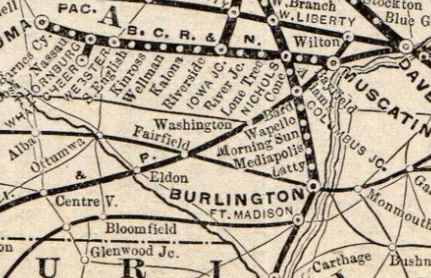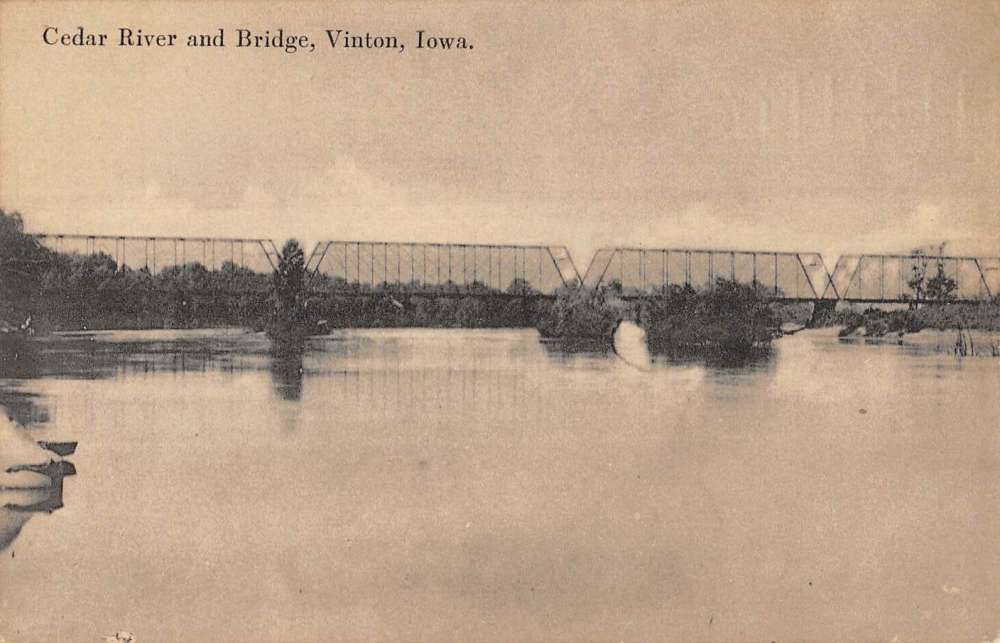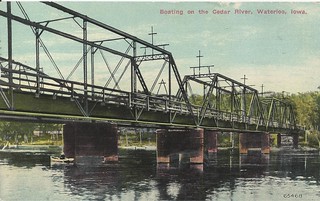A Journey Due North
This article appeared in the Centerville (Iowa) Citizen on November 23, 1872

“If the reader will trace on a county map of the United States the lines of longitude which passes through Centerville north to where it intersects the Mississippi river he will find that it passes through Goodham county, Minnesota. Just west of this is the county of Rice the “objective point” of our journey, nearly enough “due north” to answer this title.
But our journey was not pursued over the line of longitude in question. If it had been, regardless of railroad facilities, we should scarcely have been back here to report at this day. We are not too perpendicular in our notions to travel by rail, albeit the railway zigzag somewhat in its course, provided there are a pair of rails, that they are of iron or steel, securely spiked down, and between us and them is a comfortable car on wheels. As for that primitive mode of traveling “by rail” where the traveler is brought into rude contact with the rail as a vehicle, we have no anxiety to try its accommodations, even with a free pass.

From Centerville to Columbus Junction, over the Southwestern Road the route is so familiar to our readers, either by travel or report, that we need not dwell upon it. When we left, November first, the forests along the line which a few weeks before were gorgeous in their autumn hues of brown and russet and scarlet and crimson, were now already becoming stripped of their leaves and some of their glories. Our mellow and splendid October had come to a close, and a pre-election storm (Reader’s Note: In 1872 President Grant was re-elected), designed to test the mettle of lukewarm voters, had set in. No more mild summer days now, no more time for deliberate argument, whether high or inspiring, or merely clap-trap and demagogic, no more spread-eagle spouting, no time now, if ever, for wavering and indecision; in short it was November.
Of that storm of ballots on the fifth of November which “came down as still as snowflakes fall upon the sod” (Reader’s Note: The writer is quoting a poem called “The Ballot” by the American poet, John Pierpont’s ) we do not need to write now. Under the brightening skies of renewed concord, firmly maintained faith and financial disaster exerted, we trust it will be seen of all that it was like the blessed rain of Providence falling alike upon the just and upon the unjust. It will be understood that our journey was not all continuous; but for present purposes we may speak of it as one.

From Columbus Junction we travel northward over the line of the Burlington, Cedar Rapids and Minnesota Railway, which carries us almost entirely across the State of Iowa into the State of Minnesota. The principal towns along its lines are Cedar Rapids, with its fine waterpower mills and factories; its four lines of railway, its railroad men and their headquarters; its Normal School (a private institution); its daily newspaper and enterprising businessmen who instead of waiting for something to “turn up” go to work and turn it up; its extensive pork packing establishments, which promises to be an important addition to the business of the town, and other industries which we have no space to specify.

Shellsburg a town of perhaps 500 inhabitants, nearly destroyed some months since by fire, but rising again; (Reader’s Note: On April 12th of 1872 a fire in Shellsburg destroyed eighteen buildings, with a loss of about $30,000. The fire began in a saloon owned by J. Drefahl); Vinton, county seat of Benton with a valuable water power lying dormant in the volume of the Cedar River waiting for capital and enterprise to coin it into wealth and increased population; its State College for the Blind, under the able and excellent superintendency of Prof. S. A. Knapp, a cultured gentleman, admirably fitted for his post; its branch railway now building westward into northern Tama, where the new towns of Dysart and Traer are preparing to welcome the locomotive; its fine residences and business structures; and above all its intelligent and hospitable people of whom this writer retains many a pleasant remembrance;

Laporte (Reader’s Note: Presently called La Porte), a portal to Blackhawk county, a thriving place of a thousand people with a valuable mill-stream and mill and other industries; Waterloo county seat of Blackhawk, the queen city of the upper Cedar, firmly encamped on both banks of that noble stream, which turns the city’s mill-wheels on the way to the Mississippi; and asks no pay; it’s beautiful and substantial iron bridge, connecting the two Waterloos; its numerous and substantial business houses and its business men of widely known enterprise; its two railroads, the BCR&M and the Illinois Central which has also its machine shops here. We tarried a few hours here and visited the well-equipped offices of these two model papers, the Courier and Reporter, the last-named of which has a new and costly building of its own, and connected with it an extensive bindery and blank book manufactory. Five miles further up is Cedar Falls a formidable rival to Waterloo, in fact the older town, with large mills and other industries, evidently a very flourishing and wealthy city. But we have no time to tary.
The remainder of this article was apparently published the next week on November 30, 1872. Unfortunately, this paper is currently unavailable on-line and therefore we will end our journey here for now and hope that at a later date the November 30 edition can be located.